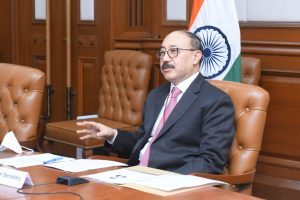India’s Foreign Secretary Harsh Vardhan Shringla today began a two-day official visit to Myanmar, his first visit to the country since 2020 and the country’s first official outreach to the military junta that seized power in February of this year.
According to a statement from India’s Ministry of External Affairs, Shringla will “hold discussions with the State Administration Council, political parties and members of civil society.” It added that he would discuss “issues relating to humanitarian support to Myanmar, security and India-Myanmar border concerns, and the political situation in Myanmar.”
The latter was a typically anodyne way of referring to the maelstrom of crises that have swept Myanmar since the military deposed the civilian government led by Aung San Suu Kyi, tanking the economy and pushing the country a state of nationwide civil war between the junta and its many opponents.
With the visit, New Delhi has effectively become the latest government to accord a degree of formal recognition to Myanmar’s military junta. As early as June, India’s East Asian rival China formally recognized the junta and has since pushed forward diplomatic engagements designed to secure its considerable economic and strategic interests in the country.
Similarly, Cambodia, the incoming chair of the Association of Southeast Asian nations (ASEAN) has signaled that it will abandon the tougher line taken (after considerable delay) by outgoing chair Brunei, and engage directly with the junta, a position that is also likely supported by its neighbors Thailand, Laos, and Vietnam. To this end, Cambodia’s Prime Minister Hun Sen will visit Myanmar next month to seek solutions to the country’s crisis.
According to a report in The Hindu, Shringla is expected to “broadbase” his meetings with opposition figures and civil society representatives “to the extent possible.” Given that most members of the parallel National Unity Government (NUG) remain either in detention or in hiding, having formally declared war on the military administration, this announcement can best be interpreted as lip service.
Indeed, India has been softly treading in the direction of official engagement for some time. Despite expressing its deep concern about the military coup and calling for a restoration of the country’s democracy, New Delhi has kept its options open. In March, Indian officials attended the notorious Armed Forces Day parade in Naypyidaw, which took place in the midst of a bloody crackdown on anti-coup protests. In June, the country abstained from endorsing a United Nations Security Council resolution that condemned the coup and sought to prevent arms supplies to the Myanmar military. Then, in November, it appointed a new ambassador to Myanmar, another sign of diplomatic business-as-usual.
While India’s economic engagement with Myanmar remains relatively modest– bilateral trade amounts to $2 billion annually, compared with $12 billon for China – India’s strategic interests in Myanmar are considerable. Most importantly, the two nations share a porous 1,600-kilometer border that abuts on to regions of eastern India that have long harbored a number of stubbornly persistent ethnic minority insurgencies. The Indian military views the Myanmar armed forces as a key partner in containing these insurgent groups, which in many cases are active on both sides of the porous border.
Last year, for instance, the Myanmar military handed over a group of 22 insurgents active in Assam to the Indian government. And the MEA’s statement regarding Shringla’s trip specifically referenced a number of recent insurgent attacks in the border region, one of which involved an armed attack on a unit of the Assam Rifles in Manipur by the People’s Liberation Front and the Manipur Naga People’s Front, which left seven people dead.
India’s second major reason for engaging with the junta is China. India and the Myanmar military share misgivings about Beijing’s growing influence in the region, which alongside border security, has formed another basis of a blooming security partnership. Myanmar coup leader Senior Gen. Min Aung Hlaing has visited India twice, including in 2019, when the countries signed an MoU on defense cooperation. Then, last year, India made the well-publicized gift of a Kilo-class submarine to the Myanmar armed forces.
As Archana Atmakuri and Mustafa Izzuddin noted in these pages last year, Myanmar is only country that is embraced by two key policies of Prime Minister Narendra Modi’s government that are at least in part motivated by China: the self-explanatory “Neighborhood First” initiative, and the “Act East” policy, which seeks to broaden New Delhi’s engagement with Southeast Asia, of which Myanmar forms India’s primary gateway.
Like Japan, the Indian government, for all its avowed concerns about the demolition of Myanmar’s limited democratic experiment, clearly feels that it cannot afford to remain indefinitely on the sidelines in Myanmar. As Suhasini Haidar of The Hindu noted yesterday, Shringla’s visit reflects “the balancing act that New Delhi is trying to maintain on upholding democratic values in the neighborhood, but also trying to counter China’s influence in Myanmar, which could grow as the regime gets more isolated.” With the government now deepening its diplomatic outreach to the junta, it would appear this balancing act is nearing collapse – if it hasn’t already.
































